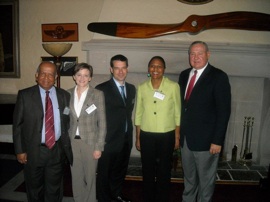GlobalInt and the Minerva Initiative


Minerva’s outreach included scenario workshops with international partners, including University College London (UCL), the International Institute for Strategic Studies (IISS), a fall symposium at AU in Montgomery ALB, the International Polar Year (IPY), University of Hawaii/PACOM, and others.
As military faculty, Tracy and Chad Briggs also had responsibility for developing new PME curricula on energy and environmental risks, including optional course outlines, officer practicums, and providing the required core course on energy security to Air Command and Staff College. In cooperation with NASA/JPL, GlobalInt also developed material for use in USAF wargames, introducing new layers that potentially complicated strategic response (e.g. volcanic ash cloud hazards), and which are now standard wargame materials for USAF.

MINERVA PUBLICATIONS
A summary of the 2010-2012 USAF Minerva efforts was published on the Woodrow Wilson Center website. An earlier 2011 Minerva Booklet was published by the Air University Press.
In addition to the Asia-Pacific strategy report, further refinement of planning tools included research publications on:
Strategic and operational environmental intelligence methods
Impacts of energy and environmental risks on military air power
Military planning tools for climate security
Scenario planning for catastrophic and abrupt risks
European planning response for Arctic energy disasters
Environmental health risks to changes in the Arctic
Planning for energy, water and food security risks in Iraq
Post-conflict environmental health assessments (Vietnam, Iraq, Sudan and Lebanon)
Global Reach. Global Perspective.


It is interesting to note that Minerva represents the Roman goddess of wisdom. The owl is her sacred companion. Owls are known for their wisdom, in part, because they can see in the dark, which is often the best place to start when looking forward into the future. In other words, good questions to ask in strategic foresight thinking are, “What do we not know?”, and, “Where are our blind spots?” It also seemed fitting for this USAF focused Minerva initiative that a bird of flight was her companion, as it also serves well as the USAF Minerva symbol.


USAF C-130H drops supplies to Ulal Island (DOD photo)
“...climate change presents security challenges of a magnitude and a complexity we have never seen before. We must be prepared for them. At the same time, we must do what we can to avoid worst-case scenarios...”
Anders Fogh Rasmussen
Secretary General, NATO
From 2010-2012, GlobalInt, in cooperation with General Dynamics IT, provided the expertise for the US Air Force’s Minerva Initiative. Chad and Tracy Briggs served as Minerva Defense Fellows, and were the Chair and Associate Chair of Energy and Environmental Security at Air University, Maxwell AFB.
The AU Minerva project was part of a wider DOD Minerva Initiative, started in 2007, to provide cutting edge research on topics of need to US security communities. GlobalInt was part of the newer Chairs Program started in 2010, offering unique opportunities for collaboration between civilian academics and military service colleges and academies.
The Minerva Team, consisting of Chad and Tracy Briggs, military consultants within GDIT, and AU faculty, had two years to complete multiple projects and outreach on a comprehensive, global scale.

AU Minerva focused on energy and environmental security at Air University which comprises all the USAF service colleges from junior officers to the Air Command and Staff College and Air War College.
The Briggs’ were asked to develop concepts of energy and environmental security (EES) for professional military education (PME), and planning tools for combatant commands and allied organizations. Specifically, the AU Minerva Chairs had to answer the questions of how EES risks could affect operational and strategic planning, and translate those risks into effective mitigation and adaptation plans. A large part of the project was dedicated to outreach toward scientific, expert and international communities.
The combatant command (COCOM) and joint planning projects were designed to provide specific and actionable information on EES risks to COCOM planners, with a focus on early warning of emerging, asymmetrical hazards.
The AU Minerva Chair and Co-chair began by advising European and North American Commands (EUCOM and NORTHCOM) on Arctic risks. By July 2011, the team was retasked to focus on Asia-Pacific concerns (PACOM, AFRICOM, and CENTCOM).
In 2011-2012 the AU Minerva team worked with the Air Force Research Institute (AFRI) to produce a 2030 strategy concept for the USAF Chief of Staff, which included a comprehensive EES assessment of critical vulnerabilities and opportunities for USAF force structure and strategy. A parallel effort developed new EES risk scenarios for Pacific Island states identifying how particular tipping points could create overwhelming security burdens for US forces in the region. These scenarios focused on humanitarian and disaster (HA/DR) planning and coordination.
The Minerva team also worked closely with NATO HQ (Emerging Security Challenges Division) in providing a workshop approach for scenario planning of EES risks. The effort was intended to build upon existing concerns in NATO’s Strategic Concept, but also provide ‘out of the box thinking on new and emerging risks specific to NATO member and partner states.

2011 USAF Minerva Symposium -
Major General Muniruzzaman, Tracy Briggs, Chad Briggs, Katie Veazie, General Charles Wald

